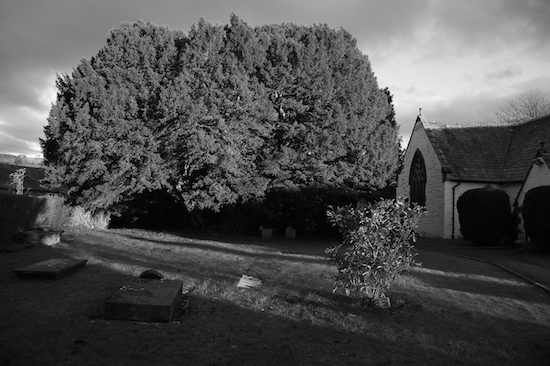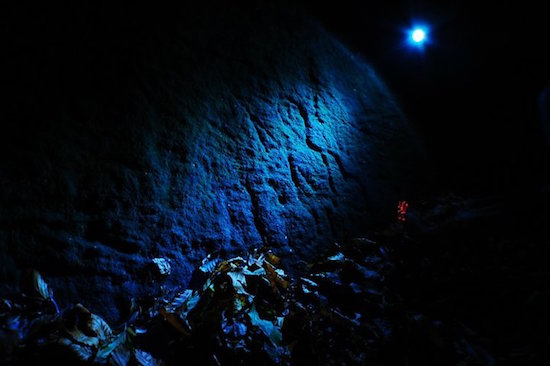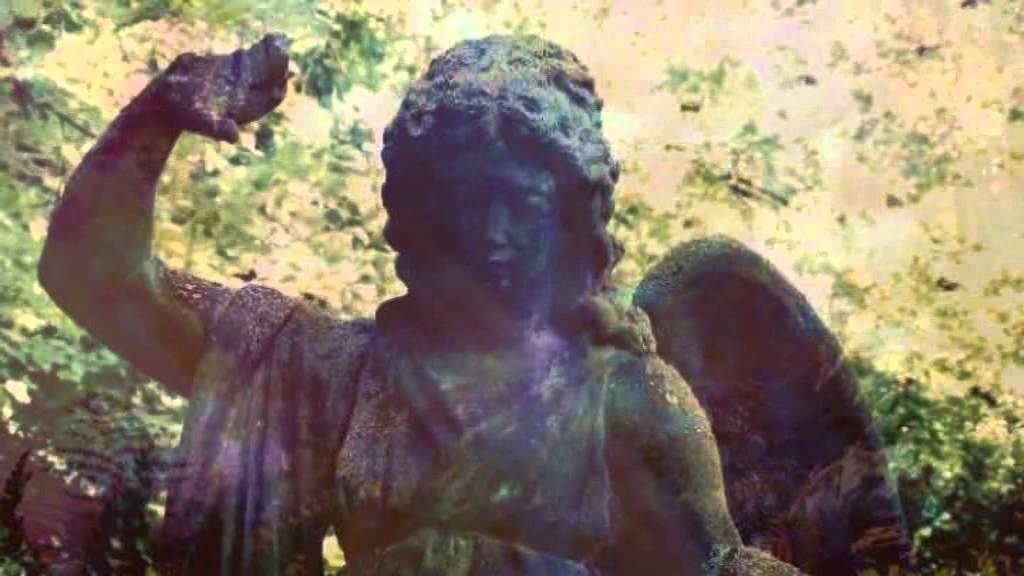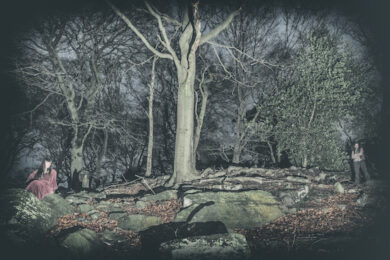Photograph courtesy of Danny Ross
Most music that reaches your ears may have started life as notes written on a stave in a silent ink or maybe patiently programmed into a mute sequencer; more often, I guess, it is born of the more audible methods of live jamming sessions or a looped phrase or rhythm. But for Hawthonn, the Leeds-based duo of Layla and Phil Legard, their most magical of musics is arrived at through journeys in both physical and metaphysical realms – a lived process, carefully mapped out and guided by combinations of locations and lore.
Their first Hawthonn project was released on Bandcamp in May 2015. Although the digitally distributed format risked it being overlooked, drowned in the ceaseless flooding of online audio, news spread wide of its curious cultivation of rural vapours, its grains of folk and beds of outsider electronics earning them many rare reviews. Consequently, the album will now get a physical release on Cold Spring this August.
Inspired by the artist Ian Johnstone’s memorial to Coil’s Jhonn Balance, Hawthonn‘s compositions draw on a fascinating range of creative processes and instrumentation. There’s the results of "audio scrying", the "shamanic rattle" of fox bones and electronic drones generated by geographical data, all deftly intertwined with folk instruments and, crucially, Layla’s haunting vocals, to embody the duo’s creed: to use "minimal tonal material for maximum impact… [through] handcrafted waveforms… privileging insight over sight, inner-vision over outer-vision".
While Phil has a back catalogue of over 20 solo recordings as the "avant-folk" Xenis Emputae Travelling Band (and was a member of avant-psych group Ashtray Navigations), Hawthonn is not the duo’s first creative project together: 2010’s Almias, a multimedia project for the Harrogate International Festival Fringe, formed around the time Phil and Layla first met and had the pair, together with Simon Bradley, focussing on Almscliffe Crag in North Yorkshire. Subsequently, 2013’s Angelystor came about during a deeply personal journey that spans the joy of their marriage and the tragedy of miscarriage soon afterwards, and is rooted in a fascination with woldest yew tree in Britain (in Llangernyw, Wales) and the field recordings that Layla made there.
The highly creative music Phil and Layla Legard make together ploughs an exquisitely resonant field found somewhere between the journey – their considered, creative process – and its destination – the finished recordings. With two new releases on the horizon we talked to the couple about their unique praxis, travelling from Jhonn Balance and Coil through folk music to paganism and beyond.
The context for your debut release was strongly drawn from Ian Johnstone’s memorial to Coil’s Jhonn Balance – you chose Bassenthwaite, where Johnstone scattered his ashes, as a locus, of sorts, for the work. What first led you to Coil’s work and in what other ways did this context affect the results?
Layla Legard: I’ve listened to Coil for years and I’ve always come back to it in certain periods of my life… I hold a special place in my heart for Coil and I felt a particular affinity with Jhonn Balance [so] I became interested in his memorial, found Ian Johnstone’s website and read about it. We don’t have a car so we can’t get to these places easily, it’s very hard to get [to Bassenthwaite] on public transport. [Instead] we started looking at the places on Google Maps and Google Earth, exploring the landscapes virtually rather than actually visiting it in person.
Phil Legard: Part of the idea was to use some of those Balance-like ideas – he talks in the interview in Fortean Times about how he’s got some Austin Osman Spare pictures and he enters into them imaginistically, explores the psychic landscapes and speaks to Spare through the pictures. Part of the notion of working with geography from afar, this kind of remote viewing idea, was inspired by medieval religious practices as well – there’s a tradition of imaginistic or imaginative pilgrimage.
LL: Like walking a labyrinth if you can’t actually make the pilgrimage to a special site.
PL: Also, Saint Bonaventure in the 13th century developed this idea that intense feelings in imaginations were a glimpse into the divine reality and could be stimulated by imaginatively recreating scenes in the Passion of Christ and things. There was another tradition where it was said that the Holy City could be found within the walls of the monk’s cell; so, we thought we could do this in the spirit of Balance with these kind of imaginative workings, and make this our pilgrimage to Bassenthwaite because at the time it was practically an impossibility. Angelystor and Almias were very much grounded in the actual places themselves and Hawthonn was a step sideways.
Yeah, you tend to start with a field recording from a significant place – are there any sound-based criteria in choosing the location or do you strictly keep to the context and take whatever you get given on the day?
PL: It’s a bit of both really. With Angelystor all I had to work with were Layla’s…
LL: …very poor quality [laughs]…
PL: …field recordings. But it’s really nice to do that because it’s like being given a piece of driftwood or using pareidolia: trying to pull the images out and work around the knot holes in the texture… It gives you a very clear mental image that you can then move away from through the music.
In the accompanying booklet to Hawthonn you refer to a compositional tool suggested by the American composer Kim Cascone as an auditory equivalent of scrying mirrors – how does that work?
PL: We created a track made of cut-ups from a 1988 interview with Jhonn Balance, cutting up small fragments, like quarter of a second long, and splitting them across the stereo field so you get one in each ear and then crossfade…
LL: You find patterns and recognisable sounds from [what is] almost white noise, you’re picking these sounds up in your unconscious. So when we listened to the [cut-up] and we wrote down the words that came from that – they became the basis for the lyrics that ended up on the first album.
PL: There are several ways that that sort of concept manifested, that one was to specifically exploit the phenomena of phantom voices. But other ones [are] to initially stimulate the imaginative visions, things like… long drones drawn from measurements on the Bassenthwaite landscape. We [called them] holophones because it was like a sonic version of a hologram – you look into them, or listen into them, and discover some kind of depth within. That came from a conversation with Kim Cascone who described his pieces as "holophonic".
Layla, your voice forms a strong part of the overall palette that you work with. It is often abstracted through processing – do you perform it after or before the rest of the piece is formed?
LL: It varies from track to track, but generally Phil would have a vague outline and then I would improvise vocals over that. Often Phil completely deconstructs the track after I’ve done the vocals and then we’d go back to it, redo the vocals on top of that… it happens side-by-side rather than a track being in existence and me putting the vocals over it or the other way around – they’re born together.
PL: Yea, to use the cliché of alchemy: recirculating, taking everything apart all the time, putting it back together, hopefully improving it.
LL: Often the tracks end up nothing like how they began. Although, obviously I’m in control of my vocals [but] what actually happens seems to be influenced by lots of things – dreams, the events that happened while we were making the album – it always seemed to be motivated by all those factors as well as the original idea.
You met in 2010 on the project that ended up as Almias, commissioned by Harrogate International Festival. How did that come about?
LL: We met slightly before that, in a bar, actually. I was talking to a mutual friend about Crowley, and he said he knew some weirdo who would be interested and introduced me to Phil. It was about six months after that [Phil] was approached by Harrogate International Festival – he knew that I was interested in local folklore, landscape and photography and asked me to work with him and our friend Simon Bradley [an oral historian and sound artist].
PL: One of the organisers who knew my earlier work as Xenis was looking for a performance or a gig, but it kind of spiraled out of control. The Almscliffe, or Almias, had always been a particularly resonant place for me: it dominates that particular part of the landscape, you can see it for miles around. I recorded quite a lot of Xenis’s material up there in the past and it seemed like a really good opportunity to do something that goes a bit deeper and concentrates on just one place on all kinds of different conceptual layers from historical to the imaginative. And the only people I could rope into it were Layla and Simon, because I think it required a bit of an obsessional approach, we were visiting it one or two times a week.
LL: [We were] spending nights up there, because I was interested in night photography at the time. There was a cave we wanted to explore because [of the] folklore behind it – somebody in the 18th century had stumbled upon the cave and been transported into this realm of mystical fairies – but it was just a really horrible, dark pothole! Basically the bottom of this crag, really dank and unpleasant.
PL: There are huge rocks hanging from the ceiling that look very precarious. One of them was called the Woggle Press because it was said to have crushed a scout at one point! We wanted to get into every nook and cranny. Part of the recording process was to take various instruments up there – a cello and accordions – and to use all these weathered pit marks on the surface as a sort of visual graphic score. We did a lot of vowel improvisations in the caves and rock shelters that outline the main body of the crag [where] it’s said there has been evidence of prehistoric habitation…
LL: …so that was how we met and by the end of the year we were living together and the rest is history.
For your next release, Angelystor, it begins with footsteps, rural ambience and then the sound of a car. It’s interesting you didn’t edit out the human sounds, particularly the car – it’s rare in field recording.
PL: It was quite important to have an actual representation of the place – even in rural Wales you’ve got cars going up and down, it’s not completely remote. The recording is a kind of palimpsest that you extract things [from] that you wouldn’t normally have thought of – those car sounds were very useful because they were these swooping bands of noise which, later in the piece, when you hear these high-pitched hisses, which sound like wind in the trees, those were actually the sound of the car.
LL: Those recordings were important to the piece because the whole story, our personal story behind Angelystor, revolved around my journey there and the fact that I was pregnant at the time but then a few months later I miscarried. Angelystor was a response to that event in our lives, so if we had rerecorded or changed or edited out any part of that then it would have diminished the personal impact of the piece for us, if that makes any sense?
Definitely. The graphic novelist Warren Ellis introduces the book that accompanies the album, saying for him "it evokes perfectly a time when we explained our own landscapes to each other in terms of magic, mystery and mantra". Is encouraging a return to a different kind of relationship with place at the root of your work?
LL: Yea, I think so. We both have a very deep spiritual connection to the landscape and that’s something that we want to impress upon our children because I think that’s missing from the public consciousness at the moment, where people live inside these very artificial worlds, like online and watching television. I want to impress upon my own child that this world we’re given is more important than just us and we have to revere it and have a connection to it. [All] at the risk of sounding like a big hippy – probably it would be fair to classify us as big hippies [laughs]!
PL: I have always been attracted to landscapes, nature and so on, particularly the way you can look at a landscape and see history – hundreds or thousands of years unfolded in front of you… There’s also the way that being in nature, or a particular kind of landscape outside of the city, really releases your awareness in many ways. It’s a really engaging, almost overwhelming, thing. Going to these places induced, in itself, some kind of change in consciousness; and then further improvising with instruments… seemed to engage that kind of flow state where the difference between ‘self’ and ‘other’ disappears, because you’re intently focussed on playing the instrument. I’ve always thought that was a stepping stone to a more visionary state – images seem to well up once you get lost and stop worrying what your fingers are doing. In my earlier work I always interpreted these kind of images as whispering of the genus loci of the place and I would then take those back home and start editing the improvisations and field recordings down again for intent listening to carry on this narrative or conversation with the spirits. That was eventually codified in a little text called Psychogeographia Ruralis, which I wrote for a so-called visionary artist group, but it fell apart because no one could agree on the vision!

Photograph courtesy of Layla Legard
For Angelystor you mention you created a "crow scale" from recordings of the bird cawing. How does that work?
PL: A crow’s caw is quite a harsh thing, a complex noise. There is a process called Fourier transformation where you can work out the harmonic content of a given sound, and using this procedure I reduced the crow caws to see their harmonic content. The various ‘sub sounds’ that make it up, some are louder than others, which gives it its unique timbre. I picked out the strongest partials to use as a scale, because each partial relates to a certain frequency which can be related to certain notes, and that became the tonal material for Angelystor.
The tonal stuff you play on flute, harmonium and other acoustic instruments has a sense of traditional folk music. Is this an area you’re interested in?
LL: Oh definitely, it’s been integral to our relationship. When we first started seeing each other we were going to The Grove in Leeds, which is one the oldest running folk clubs in the country I think. They have a singers’ night and we used to regularly sing there. I’m a Morris dancer as well. We’ve evolved around folk music and folk tradition.
PL: When I was doing the Xenis material, before Layla and I met, I described it as avant-garde folk music. I was using things like penny whistles, recorders and accordions, but often doing poly-modal things or chance procedures and things like that.
Your new release, Sea-Spiral Spirit, is a collection of individual tracks, as opposed to having a central concept. At over 20 minutes long, the title track takes up about a third of the release’s duration – what was the context for that?
PL: We’re both very interested in [the British poet] Peter Redgrove – his very physical sexuality and engagement with nature; I think he was quite resonant with Jhonn Balance as well. Sea-Spiral Spirit takes its name from [Redgrove’s 1972 book] Doctor Faust’s Sea-Spiral Spirit & Other Poems; it’s got all this imagery – shells spiraling and clocks and time. [Its poems are] practically impossible to sing so we ended up cutting up some sections from opening stanzas and abstracting them.
A lot of the tracks on Sea-Spiral Spirit don’t arise from that same kind of intense imaginative engagement with the material [as on the debut release, although] there are still elements of that. We really wanted to go to Falmouth and look at where Redgrove lived so, again, it evolved from the field recordings, imagining oneself on the shore feeling this culminating presence, this brooding whatever it is, the sea spiral-spirit coming out.
The first track, ‘Pan Laws’, is about moon and sun worship – does paganism mean anything to you, are you into it in on an academic or practical level?
LL: Yea, we had to address this recently when we were interviewed for Radio 4’s Beyond Belief programme about paganism. I suppose to a lot of people we would be pagans – we’re interested in magic and very much interested in local gods, Iron Age gods and things like that, and have been involved in that sort of personal practice – but we weren’t sure whether that classified us as pagans. But I think we came to the conclusion that we probably were – they introduced us on the programme – "Layla and Phil Legard are pagans!" and so I guess we’re officially pagans! [laughs]

Photograph courtesy of Layla Legard
I think it definitely impacts on my personal beliefs and my personal involvement with the landscape is very much about the older religions. Cocidius, the [local] god we have become very attached to, has this little shrine in the wood – an Iron Age shrine with a carving. We used to frequently go and leave offerings to him and libations – I guess that definitely puts us in the category of pagans, but we don’t subscribe to any modern belief systems, it’s all very much about our engagement and our personal responses.
PL:…and the local landscape. I don’t think we’d have been pursuing a numinous feel of nature had we not encountered this local god Cocidius through the fact that several hundred years ago a Romano-Celtic soldier had been passing through these woods, camped there and made this carving. It almost imbues this area or place with that particular association; whereas, I always felt very uneasy about pagans going, "Hecate, Diana, Isis…", all this cobbling together of ideas, this kind of cultural appropriation made me a little uneasy but, I suppose, that’s what we’re doing in a way. You can’t escape it, but I have always felt that it should be appropriate to one’s dwelling place perhaps.
LL: But that’s just how we operate, we’re very much interested in local history so it makes sense for us to go to these places and experience them and attach these experiences.
PL: The way traditions develop, there really is no such thing as tradition, it’s all a continuum of constant development.
Your next full-length release is going to be based around the Lars von Trier film Antichrist. What is it about the film that made you choose it for an album project and how might your work with locations draw from that film?
LL: I just found it such an emotional experience; it took me to such a strange place. This kind of self-destructive, quite aggressive aspect of femininity I found really interesting because just after you have given birth is a time when you don’t have control of your emotions and you’re in this very animalistic state. I was really set on edge by it and inspired by it. I don’t usually feel inspired to write about film but I wrote an essay about how the film felt to me to be a reflection of this myth that exists in various countries that once women rule, they abuse their position and have to be overthrown by men and that’s why they’re in a subdued position in society now. Also I was very interested in the idea that the wilderness is a reflection of this cruel and animalistic state that women have – the hormonal response to their bodies overrides their logic. And I need that kind of extreme response to be creative.
PL: I think we’ve always been aware of the idea of trying to avoid romanticising nature as this kind of pastoral, nurturing thing. Whereas that is a significant part of it, there are also the harrowing aspects. Layla did some research into the filming locations and we also arrived at these descriptions by Tacitus of the Black Forest as this completely inhospitable, impassable pagan kingdom.
We’ve been trying to find people who have done field recordings of [the Black Forest] but no one has, it is still quite a dangerous place. There’s a Hells Angels clubhouse within the forest and so it’s a place where they don’t recommend people, particularly tourists, to venture. That’s like the last remnants of the primeval woodland that would have covered most of Europe at one point.
I was quite taken by the sound in the film – would you use that as raw material?
LL: We watched a documentary about the sound design in the film and were interested in some of the sounds they use. I don’t know if we’d actually sample the film itself, not sure if that’s the sort direction we want to go in.
PL: I’m fairly against it, I’ve always had the opinion that everything that we do has to be our own work, so no samples really.
LL: But we were testing out the way they used a blade of grass, where you can make quite unearthly shrieks [when] blown between your fingers.
PL: I think aspects of the sound design are very relevant. Quite a lot of the sounds in the soundtrack are played through rubbing rocks together and rolling stones and things like that, so I think that’s the area we’re going to source a lot of the raw materials from.
Like Hawthonn, it has to be organic, it only develops through the doing of the project and that kind of imaginative engagement. We didn’t really know where Hawthonn was going until the final dreams and reveries presented themselves. During the process you gather all this incidental material that fits in some way – [pointing to their son] you actually hear this boy, Lovernios, on the midsection of ‘Thanatopsis’ [Hawthonn‘s closing track].
LL: Talking to nobody!
PL: We’d just finished doing a part of that track, experimenting with where to go next. We’d been working with these frequencies from the spiricom, which is a radiative device designed to speak to the dead, and around midnight we decided to go to bed and then ‘Vern sat up and was talking to thin air, very animatedly, something he’d never done before or since. So the kind of yelps that are on the mid section of ‘Thanatopsis’ were recordings of him – quite an unnerving experience really. Hopefully Antichrist will evoke some similar phenomena, but fingers crossed it won’t be so malevolent that you never hear from us again! [laughs]
Sea-Spiral Spirit is out now on Reverb Worship. Hawthonn, accompanied by films by The Psychogeographical Society’s Stuart Silver, will be showing as part of Chaostrophy at Ludwig Gallery in Berlin until July 24; for full details and tickets, head here




